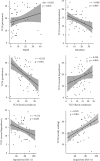The Role of Temperament Traits in Bipolar Disorder: Neuroimaging Study
- PMID: 40384807
- PMCID: PMC12085249
- DOI: 10.1155/da/5974860
The Role of Temperament Traits in Bipolar Disorder: Neuroimaging Study
Abstract
Purpose: This study aimed to identify temperament traits alterations in bipolar disorder (BD) and explore their potential neuroimaging correlates using resting-state functional magnetic resonance imaging. Methods: We assessed seed-to-voxel alterations in four large-scale brain networks (Salience, Frontoparietal, Default Mode, and SensoriMotor) in 49 patients with BD and 49 healthy individuals according to the difference of temperamental traits (Reward Dependence, Novelty Seeking, Harm Avoidance, and Persistence). Also, we measured the relationship of temperamental traits with the severity of manic and depressive symptoms and impulsivity. Results: Lower Reward Dependence (t-Welch's (87.1) = -2.50; p=0.014) in bipolar patients was associated with increased functional connectivity between Salience Network and Default Mode and FrontoParietal Networks. Higher Novelty Seeking (t-Welch's (87.3) = 4.37; p < 0.001) was associated with increased functional connectivity within FrontoParietal Network, whereas its functional connectivity with Visual and Dorsal Attention Networks was decreased. Higher Harm Avoidance (t-Welch's (82.8) = 4.85; p < 0.001) was associated with increased functional connectivity between FrontoParietal Network and basal ganglia. Lower Persistence (U = 998; p=0.002) was associated with decreased functional connectivity within FrontoParietal Network and with Default Mode Network. Higher persistence in bipolar patients was associated with greater severity of manic symptoms (Spearman's rho = 0.302, p=0.018), while lower Reward Dependence was associated with increased severity of depressive symptoms (Pearson's r = -0.388, p=0.003). Harm Avoidance negatively correlates with Persistence (Pearson's r = -0.525, p < 0.001) and positively with reward dependence (Pearson's r = -0.259, p=0.036). We also found a negative correlation between impulsivity and Reward Dependence (Pearson's r = -0.312, p=0.029) and positive correlation between impulsivity and Novelty Seeking (Pearson's r = 0.525, p < 0.001). Conclusions: The findings demonstrate a possible functional neuroimaging basis for altered temperamental traits in patients with bipolar disorder.
Keywords: bipolar disorder; functional connectivity; impulsivity; neuroimaging; temperament.
Copyright © 2025 Kirill Markin et al. Depression and Anxiety published by John Wiley & Sons Ltd.
Conflict of interest statement
The authors declare no conflicts of interest.
Figures





Similar articles
-
Disease-specific alterations of effective connectivity across anti-correlated networks in major depressive disorder and bipolar disorder.Prog Neuropsychopharmacol Biol Psychiatry. 2025 Mar 20;137:111283. doi: 10.1016/j.pnpbp.2025.111283. Epub 2025 Feb 6. Prog Neuropsychopharmacol Biol Psychiatry. 2025. PMID: 39921029
-
Disrupted default mode network connectivity in bipolar disorder: a resting-state fMRI study.BMC Psychiatry. 2024 Jun 7;24(1):428. doi: 10.1186/s12888-024-05869-y. BMC Psychiatry. 2024. PMID: 38849793 Free PMC article.
-
Novelty seeking and reward dependence-related large-scale brain networks functional connectivity variation during salience expectancy.Hum Brain Mapp. 2017 Aug;38(8):4064-4077. doi: 10.1002/hbm.23648. Epub 2017 May 17. Hum Brain Mapp. 2017. PMID: 28513104 Free PMC article.
-
[Personality factors in depressive disorders: contribution of the psychobiologic model developed by Cloninger].Encephale. 2002 Jul-Aug;28(4):363-73. Encephale. 2002. PMID: 12232546 Review. French.
-
Resting-state functional connectivity in individuals with bipolar disorder during clinical remission: a systematic review.J Psychiatry Neurosci. 2018 Aug;43(5):298-316. doi: 10.1503/jpn.170175. J Psychiatry Neurosci. 2018. PMID: 30125243 Free PMC article.
References
-
- Kasyanov E. D., Merkulova T. V., Kibitov A. O., Mazo G. E. Genetics of Bipolar Spectrum Disorders: Focus on Family Studies Using Whole Exome Sequencing. Russian Journal of Genetics . 2020;56(7):786–801. doi: 10.1134/S1022795420070054. - DOI
MeSH terms
LinkOut - more resources
Full Text Sources
Medical

